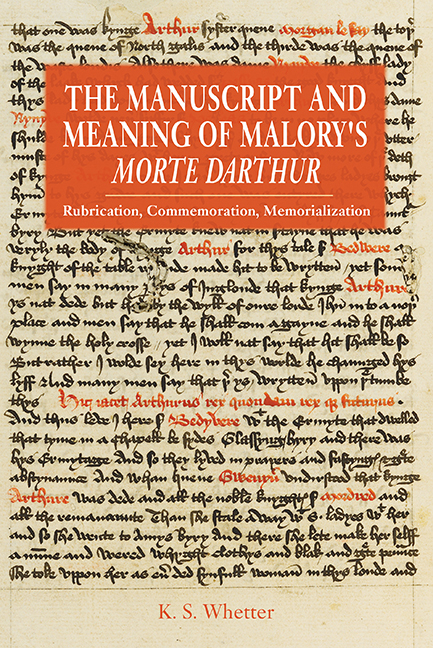Book contents
- Frontmatter
- Dedication
- Contents
- List of Plates
- Acknowledgements
- Abbreviations
- A Note on the Text
- A Textual Introduction
- 1 The Unusual Nature of Winchester's Rubrication
- 2 Tracing Winchester's Rubrication and Marginalia
- 3 Malory's Sacralized Secularity
- 4 Rubricated Elegy
- Conclusion: The Red and the Black
- Bibliography
- Index
- Miscellaneous Endmatter
1 - The Unusual Nature of Winchester's Rubrication
Published online by Cambridge University Press: 28 April 2017
- Frontmatter
- Dedication
- Contents
- List of Plates
- Acknowledgements
- Abbreviations
- A Note on the Text
- A Textual Introduction
- 1 The Unusual Nature of Winchester's Rubrication
- 2 Tracing Winchester's Rubrication and Marginalia
- 3 Malory's Sacralized Secularity
- 4 Rubricated Elegy
- Conclusion: The Red and the Black
- Bibliography
- Index
- Miscellaneous Endmatter
Summary
Prolegomena: Malory's Red and Black
For the better part of five and a half centuries, the story known today as Le Morte Darthur existed in only one version: that printed by William Caxton in 1485. According to Caxton, this English Morte Darthur was modelled ‘after a copye unto me delyverd, whyche copye Syr Thomas Malorye dyd take oute of certeyn bookes of Frensshe and reduced … into Englysshe’. Richard R. Griffith takes Caxton's delivery statement quite literally, speculating that Caxton's copy-text may well have been a reasonably ‘fair’ but far from elaborate authorial manuscript, not nearly as decorated as Winchester, and thus more easily marked up and taken apart for printing purposes.Griffith's argument is part of his larger case for the author of the Morte Darthur being the Papworth St Agnes Malory, from Cambridgeshire. This view has not found wide acceptance amongst Malory scholars, and Griffith's account of Caxton's copy-text, though highly interesting, is quite speculative. The question of where Caxton acquired his copy-text, however, once again raises the issue of Winchester's relation to the Caxton print. Textual errors in the early print history of Malory's work reveal that, whatever Caxton's copy-text manuscript looked like, it was quickly lost to later printers. Instead of being printed from the manuscript, almost all versions of the Morte printed after Caxton were based on a Caxton incunable.Or rather, they were based on copies of Caxton. Wynkyn de Worde, Caxton's apprentice and successor, seems to have had access to Caxton's copy-text as well as Caxton's incunabula, and to have used the original copy-text to make some corrections for his reprinting of the Morte Darthur in 1498, but apart from de Worde's first edition, the early texts of Morte Darthur were Caxton texts. In fact, by the mid-sixteenth century they were not even that; the print tradition had quickly degraded, with new printings being based on copies of previous copies rather than the Caxton. It was not until the nineteenth century that Robert Southey with William Upcott (1817), and then Sir Edward Strachey (1868), went back to the Caxton directly in an attempt to create a more accurate text; even then Upcott had to fill in several lacunae in his copy-text, and Strachey partly modernized his text. It was not until H. Oskar Sommer's edition (1889–91) that a reasonably scholarly text and apparatus appeared.
- Type
- Chapter
- Information
- The Manuscript and Meaning of Malory's Morte DarthurRubrication, Commemoration, Memorialization, pp. 23 - 65Publisher: Boydell & BrewerPrint publication year: 2017

